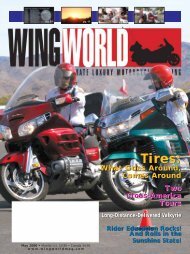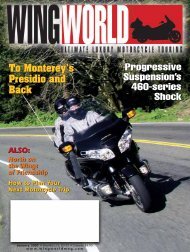Wing Ding 30 Official Program - Wing World Magazine Archives
Wing Ding 30 Official Program - Wing World Magazine Archives
Wing Ding 30 Official Program - Wing World Magazine Archives
Create successful ePaper yourself
Turn your PDF publications into a flip-book with our unique Google optimized e-Paper software.
interval was listed for that bike, either. In fact,scheduled fork oil changes haven’t appearedin the service manuals or owner’s manuals ofany Gold <strong>Wing</strong> since the very first edition—the GL1000. Even then, the GL1000’s fork oilchange interval was every 24,000 miles (aftera break-in change at 1,000 miles). So whywere there fork drain screws on every modelexcept the GL1800? My hunch is that it wassimply a carryover from the GL1000 design,and someone finally realized it was pointless,given that no change interval was specified.This is why it’s so important to not drain thefork oil on any <strong>Wing</strong> (other than that GL1000)and simply pour in the “recommended quantity.”Except for the GL1000, that recommendedquantity applies only to clean, dry,freshly assembled forks. A significant quantityof oil remains trapped in the bushings andbetween the tubes, so using that quantity torefill forks that have merely been drained willresult in an overfill condition that could resultin a less-than-comfortable ride.So what to do? Some may find the followingcontroversial, but I believe it’s the bestmethod of approaching this issue. Aside fromthe methods of damping and the stanchiondiameter, the forks and seals on later model<strong>Wing</strong>s differ little in design from those on theGL1000. So, in the absence of conditionsrequiring complete fork disassembly forrepair, the recommended change interval forthe 1000 may serve as a guide for later modelsas well. For all <strong>Wing</strong> models other than theGL1000, drain the oil by removing the forks,remove the springs and spacers, invert theforks into a drain pan, and allow them todrain for at least 15 minutes. Pump the forksto get out as much oil as possible. For theGL1100 and 1200, reduce the recommendedoil quantity by 50cc, and pour that amountinto the forks. Insure the oil level is the samein both forks, then complete reassembly andreinstallation. For the GL1500, follow theprocedure for earlier model forks, but pour inthe entire recommended amount. Pump theforks to distribute the oil. Then, with the forksheld compressed and vertical, use an oil levelsetting tool to adjust the levels to that shownin the service manual before installing thesprings and caps. Use this same procedure forthe GL1800 forks with the following difference.The damper cartridge in the right forkmust be pumped dry after draining the tubes,and it must be pumped again to refill it afterpouring in the fresh oil and before adjustingthe oil level. Many folks find it far too muchtrouble to perform all of this work and havedevised many creative methods of doing whatthey believe is an equivalent job. If they’resatisfied with the result, more power to them.If not, they might consider trying the method Isuggest here.Stu●48 <strong>Wing</strong> <strong>World</strong>
















